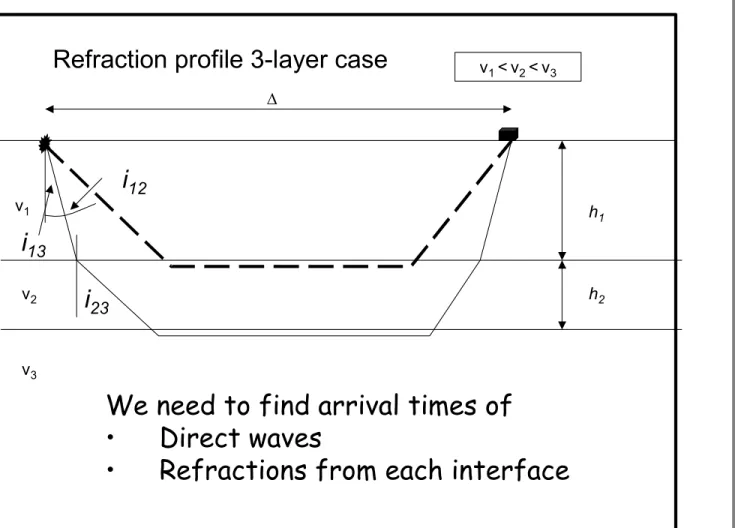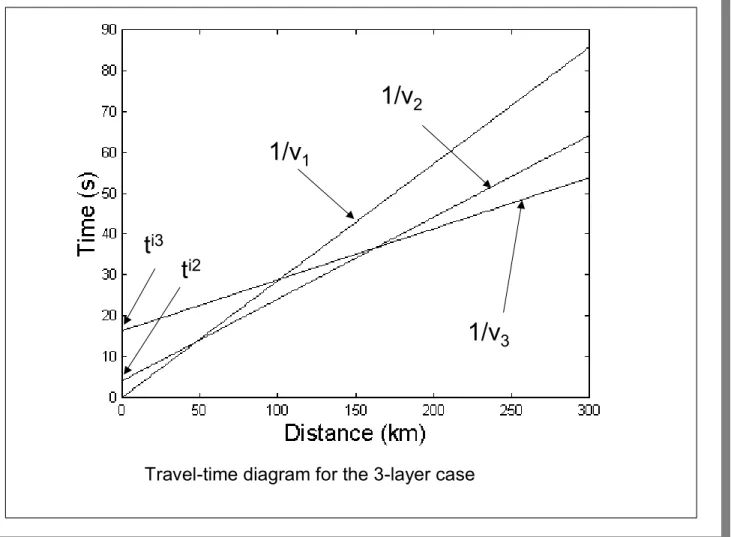Body Waves and Ray Theory Body Waves and Ray Theory
• Ray theory: basic principles
Wavefronts, Huygens principle, Fermat’s principle, Snell’s Law
• Rays in layered media
Travel times in a layered Earth, continuous depth models,
Travel time diagrams, shadow zones, Abel’s Problem, Wiechert-Herglotz Problem
• Travel times in a spherical Earth
Seismic phases in the Earth, nomenclature, travel-time curves for teleseismic phases
Basic principles Basic principles
• Ray definition
Rays are defined as the normals to the wavefront and thus point in the direction of propagation.
• Rays in smoothly varying or not too complex media
Rays corresponding to P or S waves behave much as light does in materials with varying index of refraction: rays bend, focus, defocus, get diffracted, birefringence et.
• Ray theory is a high-frequency approximation
This statement is the same as saying that the medium (apart from sharp discontinuities, which can be handled) must vary smoothly compared to the wavelength.
Wavefronts - Huygen’s Principle Wavefronts - Huygen’s Principle
Huygens principle states that each point on the wavefront serves as a secondary source. The tangent surface of the expanding waves gives the wavefront at later times.
Fermat’s Principle Fermat’s Principle
Fermat’s principle governs the geometry of the raypath. The ray will follow a minimum-time path. From Fermat’s principle follows directly Snell’s Law
2 1
sin sin
i
Rays in Layered Media Rays in Layered Media
Much information can be learned by analysing recorded seismic signals in terms of layered structured (e.g. crust and Moho). We need to be able to predict the arrival times of reflected and refracted signals …
… the rest is geometry …
Travel Times in Layered Media Travel Times in Layered Media
Let us calculate the arrival times for reflected and refracted waves as a function of layer depth d and
velocities i i denoting the i-th layer:
We find that the travel time for the reflection is
And the refraction
i Trefl d
cos 2
1
c refr
i d
X r
r i
T d
tan 2
cos 2
2 1
Three-layer case Three-layer case
Refraction profile 3-layer case
i12
h1
Figure 3: Geometry of 3-layer refraction experiment.
v1
v2
v1< v2 < v3
v3
i23 i13
h2
Refraction profile 3-layer case
i12
h1
Figure 3: Geometry of 3-layer refraction experiment.
v1
v2
v1< v2 < v3
v3
i23 i13
h2
We need to find arrival times of
• Direct waves
• Refractions from each interface
Three-layer case: Arrival times Three-layer case: Arrival times
2 2
2 1
12 1
2
cos 2
t v v
v i
t h i
1
1 /v
t
3 3
33 2
23 1
13 sin sin 1
sin
v v
i v
i v
i
3 3
3 2
23 2
1 13 1
3
3
cos 2
cos 2
t v v
v i h
v i
t h i
ti
Direct wave
Refraction Layer 2
Refraction Layer 3
using ...
Three-layer case: Travel time curves Three-layer case: Travel time curves
ti2 ti3
1/v1
1/v2
1/v3
Figure 4: Travel-time diagram for the 3-layer case
ti2 ti3
1/v1
1/v2
1/v3
Figure 4: Travel-time diagram for the 3-layer case
Travel Times in Layered Media Travel Times in Layered Media
Thus the refracted wave arrival is
where we have made use of Snell’s Law.
We can rewrite this using
1 2
/ 1 2 1 2 2
/ 1 2
2 cos (1 sin ) (1 )
/
1 p ic ic p
c c
refr i
X d i
T d
cos 2 1
cos 2
2
1 2
1
to obtain
2d1
Xp Trefr
Which is very useful as we have separated the result into a vertical and horizontal term.
Travel time curves Travel time curves
What can we determine if we have recorded the following travel time curves?
Generalization to many layers Generalization to many layers
The previous relation for the travel times easily generalizes to many layers:
n
i
i i
refr Xp d
T
1
2
Travel time curve for a finely
layered Earth. The first arrival is comprised of short segments of the head wave curves for each layer.
This naturally generalizes to
infinite layers i.e. to a continuous depth model.
Special case: low velocity zone Special case: low velocity zone
What happens if we have a low-velocity zone?
Then no head wave exists on the interface between the first and second layer.
In this case only a refracted wave from the lower half space is observed. This could be misinterpreted as a two layer model. In such cases this leads to an overestimation of the depth of layer 3.
Special case: blind zone Special case: blind zone
The situation may arise that a layer is so thin that its head wave is never a first arrival.
From this we learn that the observability of a first arrival depends on the layer thickness and the velocity contrast.
Travel Times for Continuous Media Travel Times for Continuous Media
We now let the number of layers go to infinity and the thickness to zero. Then the summation is replaced by integration.
Now we have to introduce the concept of intercept time of the tangent to the travel time curve and the slope p.
The (p) Concept The (p) Concept
Let us assume we know (observe) the travel time as a function of distance X. We then can calculate the slope dT/dX=p=1/c.
Let us first derive the equations for the travel time in a flat Earth. We have the following geometry (assuming increasing velocities):
Travel Times Travel Times
At each point along the ray we have
Remember that the ray parameter p is constant. In this case c is the local velocity at depth. We also make use of
ds cp i dx sin
p dz c
dx cp
i cp i dz
ds dx
p c ds i
i dz
2 2
2 2 2
1 sin cos
1 sin
1 cos
Travel Times Travel Times
Now we can integrate over depth
This equation allows us to predict the distance a ray will emerge for a given p (or emergence angle) and velocity structure, but how long does the ray travel?
Similarly
z
p dz c X cp
0 1 2 2
2
c T
dT ds
path
z
i z
c
dz s
c ds
0 ( )cos ) 2
(
z
p c
c T dz
0 2 1/ 2 2
2
Travel Times and (p) Travel Times and (p)
This can be rewritten to
Remember this is in the same form as what we obtained for a stack of
layers.
Let us now get back to our travel time curve we have
pX z c z p dz T
0
2 2( )
/ 1 2
n
i
i i
refr pX d
T
1
2
dz p z
c pX
T p
z
0
2 2( )
/ 1 2
)
(
Intercept time Intercept time
The intercept time is defined at X=0, thus
As p increases (the emergence angle gets smaller) X decreases and will decrease. Note that (p) is a single valued function, which makes it easier to analyze than the often multi-valued travel times.
X
p dz z
c
p
dz p z
dp c d dp
d
z
z
0 2 2
0
2 2
) ( / 2 1
) ( / 1
2
Travel Times: Examples Travel Times: Examples
The Inverse Problem The Inverse Problem
It seems that now we have the means to predict arrival times and the travel distance of a ray for a given emergence angle (ray parameter) and given structure. This is also termed a forward problem.
But what we really want is to solve the inverse problem. We have recorded a set of travel times and we want to determine the
structure of the Earth.
In a very general sense we are looking for an Earth model that minimizes the difference between a theoretical prediction and the observed data:
where m is an Earth model. For the problem of travel times there is an interesting analogy: Abel’s Problem
! )
(m Min T
T theory
s traveltime
obs
Abel’s Problem (1826) Abel’s Problem (1826)
z
P(x,z)
x dz’
ds
Find the shape of the hill !
For a given initial velocity and measured time of the ball to come back to the origin.
The Problem The Problem
z
x P(x,z)
dz
’ ds
At any point: gz 1 v 2 0
2
At z-z’: mg z z( ') 1 m ds dt( / ) 2
2
After
integration: t z ds dz
g z z dz
z
( ) / '
( ') '
2 0
The solution of the Inverse Problem The solution of the Inverse Problem
P(x,z)
x z
dz
’ ds
After change of variable and integration, and...
f z d
dz
t z dz
z z z
a
( ') '
( )
' '
1
t z ds dz
g z z dz
z
( ) / '
( ') '
2 0
The seimological equivalent The seimological equivalent
Wiechert-Herglotz Method Wiechert-Herglotz Method
Distance and Travel Times Distance and Travel Times
Solution to the Inverse Problem Solution to the Inverse Problem
Conditions for Velocity Model Conditions for Velocity Model
Rays in a Spherical Earth Rays in a Spherical Earth
How can we generalize these results to a spherical Earth which should allow us to invert observed travel times and find the internal velocity structure of the Earth?
Snell’s Law applies in the same way:
2 1 1
1 sin '
sin
v v
From the figure it follows
2 2 2
1 1
1 sin sin
v r v
r
which is a general equation along the raypath (i.e. it is constant)
Ray Parameter in a Spherical Earth Ray Parameter in a Spherical Earth
v p
r sin
... thus the ray parameter in a spherical Earth is defined as :
Note that the units (s/rad or s/deg) are different than the corresponding ray parameter for a flat Earth model.
The meaning of p is the same as for a flat Earth: it is the slope of the travel time curve.
d p dT
The equations for the travel distance and travel time have very similar forms than for the flat Earth case!
Flat vs. Spherical Earth Flat vs. Spherical Earth
z
p dz c
X cp
0 1 2 2
2
z
p c
c T dz
0 2 1/ 2 2
2
Flat Spherical
0
1
2 2
2 2 r
r
p dr c
r r
cp
0
1
2 2
2 2
2
2 /
r
r c r r c p
dr T r
Analogous to the flat case the equations for the travel time can be seperated into the following form:
Flat vs. Spherical Earth Flat vs. Spherical Earth
Flat Spherical
The first term depends only on the horizontal distance and the second term and the second term only depends on r (z), the vertical dimension.
These results imply that what we have learned from the flat case can directly be applied to the spherical case!
z
dz p z
c pX
T
0
2 2( )
/ 1
2 1
0
2
2 2
2 / ( )
2
r
r
r dr
p z
c p r
T

